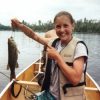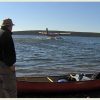Quetico Solitaire
I’m four days into my weeklong solo trip into the Quetico and 48-plus hours into a stretch where I haven’t seen another soul. It’s mid-July. I’m paddling through an expanse of calm, clear water with cliffs rising on my left and a spill of islands spreading out to my right. It’s just me and the water and the rocks and the trees. The BWCA, not that far to my south in miles, seems rods and rods distant from where I’m at right now. I know it’s crawling with people racing for campsites, bottlenecking portages, and leaving a trail behind them. Me, I’m in a canoe-world the likes of which I’ve never paddled through before.
I’ve got a wilderness to myself.
My journey through Ontario’s Quetico Provincial Park, the Boundary Waters Canoe Area’s Canadian counterpart, wasn’t completely “unpeopled and still” and not every moment dissolved the barriers between this human and his environment, but as a whole the trip among Agnes, Kawnipi, McDougall, Kahshahpiwi, Sarah, Robinson, and Basswood Lakes brought into focus the glories of the Canadian wilderness, the riches of a solo journey, and the value of a wilderness less traveled.
Don’t get me wrong, I think the BWCA is a fine place. I made three nice trips there this spring and summer. I know it’s the wild heart of Minnesota’s natural world and Mecca for Minnesotans of the outdoor persuasion. But, to my tastes anyway, it’s overpopulated and frayed at the edges. The cliché is that the place is being loved to death. That’s not untrue, but slobs are trashing it as well.
Maybe too, meeting other travelers at regular intervals and seeing smoke from camps across your lake provides comfort to a certain type of camper. The BWCA trip I did with a college friend and his 11 year-old son was probably just wild enough for the paddlers involved. Some people like their wilderness to be more civilized.
On this trip, though, I was looking for wilderness with a capital W and a solitary trip with a capital S. Trips with kids, trips of couples, trips to rendezvous with long lost buddies at their fishing camp – rough summaries of my three BWCA trips this year — just aren’t the same as a journey you make alone. Something simple and satisfying grows from a trip with one human, one canoe, minimal gear, and a big country to explore.
My trip was all that. The Quetico proved an ideal setting for a solo journey with a focus on covering ground and reflecting on the experience. The Quetico in July was quieter and more soloist-friendly than the BWCA in autumn – my usual soloing season – and a whole different planet compared to the BWCA in high summer.
Almost from the moment I checked-through the Prairie Portage Ranger Station – I started my trip at Moose Lake, just outside of Ely – the Canadian side had a different feel than the U.S. Through Bayley Bay of Basswood, Sunday Lake, and the portages into Agnes, I saw only a single camp and no fellow travelers. The portage trails were rougher and less maintained. Once past Louisa Falls on the south end of Agnes – a busy Quetico tourist attraction – I had the water mostly to myself; the few other parties on the lake seemed a long way away. When I camped among the islands amid that stunning lake, I had my pick of campsites.
Quetico trips demand a bit more effort than those in the BWCA. Not only is there the paddle to the ranger station – the one at Prairie Portage is one of three along the U.S. border – but there’s also paper work. As in the BWCA, paddlers need permits which regulate where and when one enters the park. In addition, U.S. paddlers need Remote Area Border Crossing Permits to enter Canada legally without first clearing customs. Since the border permits take at least six weeks to process and park permits get reserved quickly, it’s not the sort of trip you can throw together at the drop of a paddle.
But with the extra effort come the pleasures. Shortly after I left my Agnes campsite, I saw my last human for that two-day stretch. I paddled silently that next day on still lakes under gray skies examining pictographs, watching loons and their young, and enjoying the cliff-lined shores of Agnes and Keewatin Lakes. I pondered my way to Kawnipi. The combination of the weather, the silent, painted evidence of a once-thriving canoe-based culture, and the opportunity for quiet thoughts left the landscape feeling too empty. I didn’t want for more folks wrapped in fleece and paddling Kevlar. I just missed the time when the lakes and portages I crossed were the arteries of a people, not just trails for meandering vacationers like myself.
Sunnier days bring brighter thoughts. In the next three days — as I zigzagged to the west from my Kawnipi campsite through Keats and McDougall Lakes, while I bent back east the next day to Kahshahpiwi Creek via Metacryst and Cutty Lakes, and finally after I forged west again for a camp on Robinson Lake on the penultimate night on trail — I didn’t miss the old native culture, but often felt some of that boundary between canoeist and nature melt away. My paddle-strokes through the calm water seemed to dissolve some of me into the landscape. I felt myself meld with Quetico, and the Quetico with me.
Not that there weren’t events and situations during the week that broke the contemplative mood. Windy crossings, thunderstorms, rough portages, tired muscles, or just the thunk of a paddle on the gunwale brings you back to earth, from meditations thereupon. At other times, the task at hand demands full attention. Coming out on the final morning, I needed to cross the big waters of Basswood Lake. I was tired. I’d slept fitfully in my bivy-sack the night before, after I took storm shelter on an island without a tent site. (If nature and I were to be one that night, it would have been through an electrical connection.) North winds sent rollers south down Basswood making the points an adventure to clear. Reaching the calm water behind Washington Island was work, and getting from there to Moose Lake and my truck was just a job.
But as I came off the final portage and onto Moose Lake, I saw that day’s line of outfitted BWCA paddlers working its way up the east shore. I pictured them fanning out across the BWCA. I thought about my solitary days in the Quetico.
I remembered the silence and the glories.
By Charlie Mahler, Contributor
”










